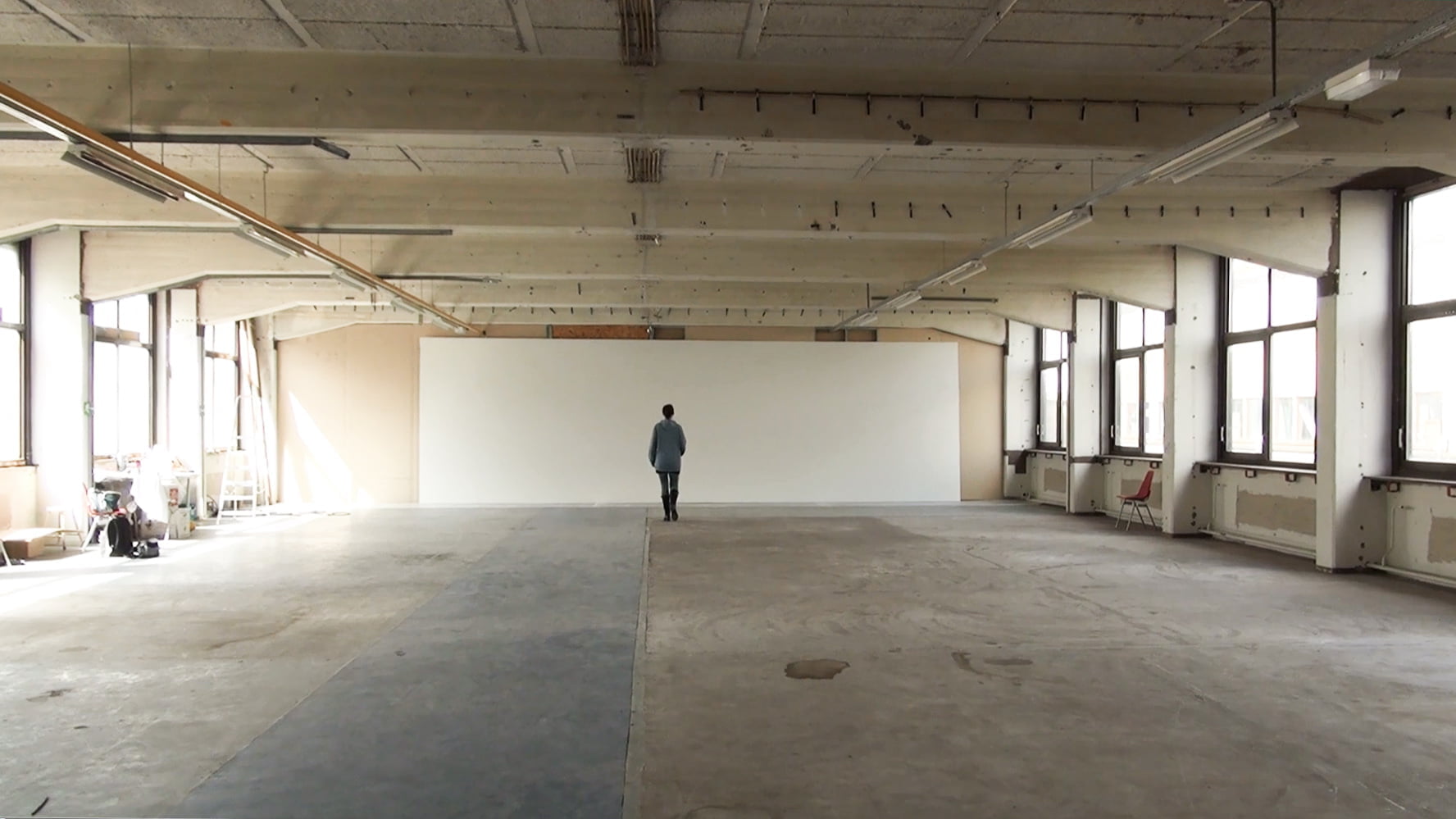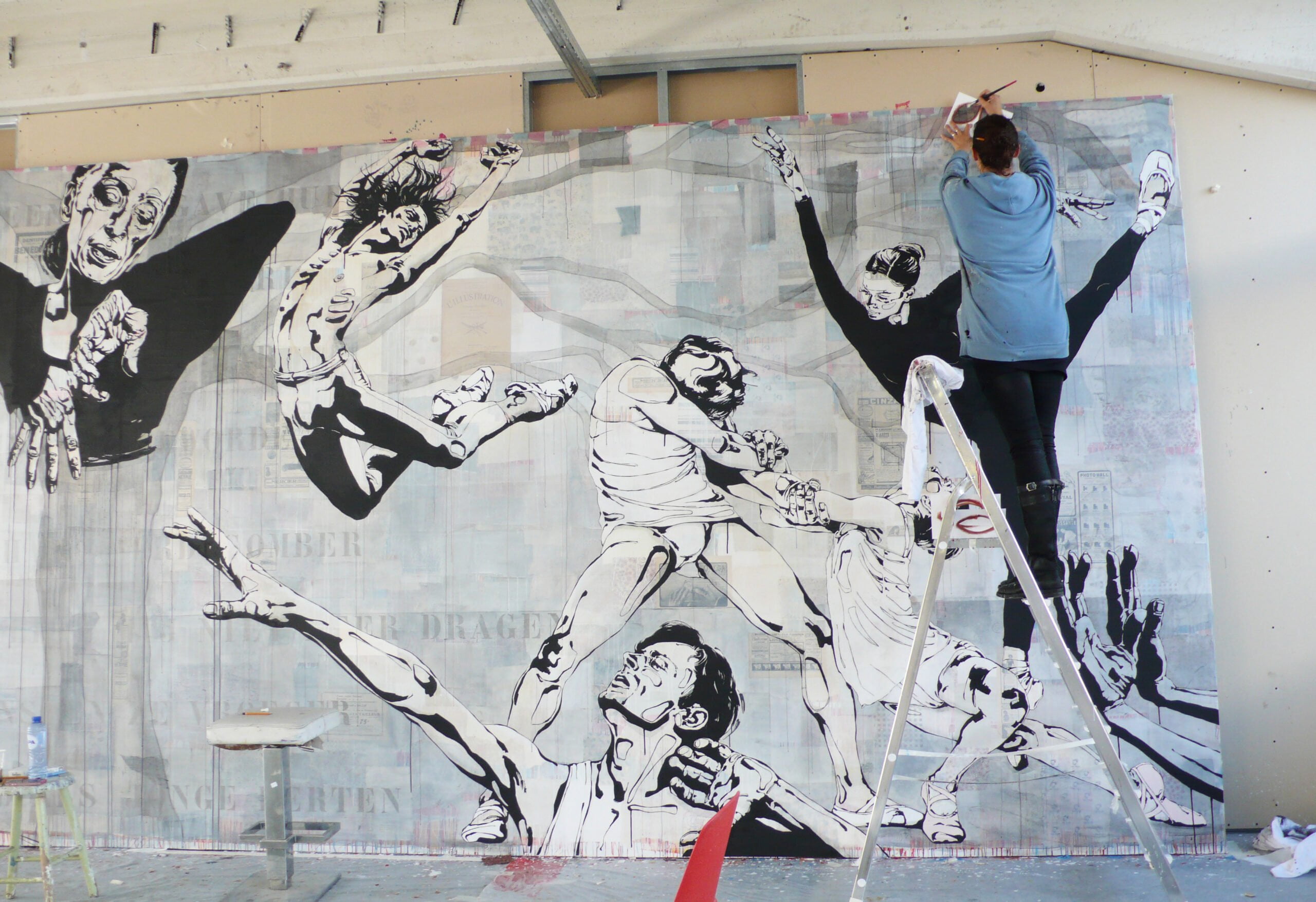— The Largest Linoleum print in the World — ‘The Tenth Muse’
‘The greatest dancers united, on the largest linoleum print in the world’
The work, entitled “The Tenth Muse”, is inspired by Greek mythology. On the canvas you can see a snapshot of the celebration of the arrival of the tenth Muse of Zeus and Mnemosyne. Each dancer is linked to a mythological figure. The characteristics and attitudes of the famous dancers are linked to the classical figures from Greek traditions. Zeus and Mnemosyne processed the nine muses in 9 nights. They are the goddesses of song, dance and poetry and they live on the Olympus. They have been a source of inspiration for artists, choreographers, writers and poets for centuries.
The dancers portrayed are, without exception, greats from the last century of ballet history, who by their fame carry a certain charge, namely with a status that itself assumes mythical proportions; Martha Graham, Mikhail Baryshnikov, Ulyana Lopatkina, Anna Pavlova, Sergei Polunin, Vaslav Nijinsky, Igone de Iongh, Margot Fonteyn, Rudolf Nureyev, Edward Watson, Alina Cojocaru (and the hands of Wendy Whelan). Six women and five men.
Watch the Video:
ABOUT THE ARTWORK
Maayke Schuitema (The Hague, 1974) is a painter and graphic artist from the Netherlands. She studied ballet at The Royal Conservatory and Fine Arts at the Royal Academy in The Hague. She works with large-scale linocuts, which are printed, by hand, on Kozo Paper especially made for her in the Prefecture of Kochi in Japan
This painting is an ode to dance. An Artwork in which she merges the two art forms that have shaped her life; art and dance. In this choreography 11 of the most famous dancers from the last century dance together once more…
I M A G I N E D ;
Martha Graham as Sappho
(May 11, 1894 – April 1, 1991) was an American modern dancer and choreographer. Her style, the Graham technique, reshaped American dance. She is invaluable for dance history and is considered the founder of modern dance.
Sappho was an Archaic Greek poet. Sappho was widely regarded as one of the greatest lyric poets and was given names such as the “Tenth Muse” and “The Poetess”
She is the central figure. Her body is dissolved. The hands make a twisting motion, a screw as if they wring out something. The characteristic human characteristic; physical aging, makes that she differs from the other nine muses, those in their divine status are immortal. The physical disappearance is literally the expiration of time, being erased slowly, but Graham’s greatness is undisputed.
Because of her age, Martha Graham as a tenth muse is comparable to the position of Sappho, the Greek poet and performed by Plato as a 10th muse, she has now given a face by the artist
Mikhail Baryshnikov as Apollo
(Russian: Михаи́ л Никола́ евич Бары́ шников, January 27, 1948) is a Russian dancer, choreographer, and actor. He is often cited alongside Vaslav Nijinsky and Rudolf Nureyev as one of the greatest male ballet dancers in history. He had a promising start in the Kirov Ballet in Leningrad before defecting to Canada in 1974 for more opportunities in western dance. And o.a. joined the New York City Ballet as a principal dancer.
Apollo has been variously recognized as a god of archery, music and dance, truth and prophecy, healing and diseases, the sun and light, poetry, and more. Apollo is the son of Zeus and Leto. Seen as the most beautiful god and the ideal of the kouros (a beardless, athletic youth), Apollo is considered to be the most Greek of all gods.
Apollo / Mikhail Baryshnikov proud but subdued in his worship at the same time as his muses singing and dancing in unison under the direction of the same Apollo, after all the god of music and poetry and the God of the Fine Arts. His arm points to the Nymph Eupheme (Anna Pavlova), the midwife of the muses.
Ulyana Lopatkina as dying swan
(Russian: Ульяна Вячеславовна Лопаткина, October 23, 1973) is a Russian prima ballerina who performed with the Mariinsky Theater from 1991–2017. She is famous for her Iconic Spiritual Transformation in her performance as Dying Swan
The theme of the Dying Swan is the ultimate dance solo for the prima ballerina. The swan reaches just like Mikhail Baryshnikov to the drips of Sappho/Martha Graham. The theme of dying is linked to the aging of Martha Graham.
The Dying Swan is a solo dance choreographed by Mikhail Fokine to Camille Saint- Saëns’s Le Cygne from Le Carnaval des animaux as a pièce d’occasion for the ballerina Anna Pavlova, who performed it about 4,000 times. The short ballet (4 minutes) follows the last moments in the life of a swan, and was first presented in St. Petersburg, Russia in 1905. The ballet has since influenced modern interpretations of Odette in Tchaikovsky’s Swan Lake and has inspired non-traditional interpretations as well as various adaptations.
Anna Pavlova as Eupheme
(Russian: Анна Павловна (Матвеевна) Павлова, February 12, 1881 – January 23, 1931) was a Russian prima ballerina of the late 19th and early 20th centuries. She was a principal artist of the Imperial Russian Ballet and The Ballets Russes of Sergei Diaghilev. Pavlova is most recognized for the creation of the role of The Dying Swan. She became the first ballerina to tour around the world.
Eupheme was the ancient Greek female spirit of words of good omen, praise, acclaims, shouts of triumph, and applause
In ‘The Tenth Muse’ she imagines Eupheme, a Nymph in the role of the midwife of the 9 muses. The Nymph is a Greek demigod who lives in nature and is often tied to a specific place or plant species. Anna Pavlova is ultra classical and is conceived as the source of the creation of this painting
Sergei Polunin as Dionysos
(Russian: Серге́й Влади́ мирович Полу́нин. Ukrainian November 20, 1989). He has Ukrainian, Russian and Serbian citizenship. He attended the Kiev State Choreographic Institute. After graduating, he joined the British Royal Ballet School. In 2010, at the age of 20, Polunin became the Royal Ballet’s youngest principal dancer ever.
Dionysos is the god of the grape-harvest, winemaking and wine, of fertility, ritual madness, religious ecstasy, and theatre in ancient Greek religion and myth. He is also known as Bacchus
Dionysos. To the right of Sappho / Martha Graham he left high in the sky. His body is bent back in a semicircle. The jump as liberation, in the vacuum. The jump is similar
to that of the Doors singer Jim Morrison, who was compared to a satyr or Dionysos. He is the favorite of the Muses.
Vaslav Nijinsky as Faun
(Russian: Ва́ цлав Фоми́ ч Нижи́ нский; 12 March 1889– 8 April 1950) was a ballet dancer and choreographer cited as the greatest male dancer of the early 20th century. Born in Kiev grew up in Imperial Russia.
Faun is a mythological half human–half goat creature appearing in Ancient Rome.
At the far left is the Faun, a creature that is usually in the company of Dionysos and the muses. Vaslav Nijinsky in a typical gesture and attitude from the piece “An afternoon of a Faun” the dance in which the Faun encounters three Nymphs and tries to seduce them. A charged image is the highlight of the temptation, the ultimate pleasure. De Faun is an androgynous character and dances for the Tenth Muse
Igone de Iongh as Terpischore
Igone de Jongh (born September 9, 1979) is considered the most famous Dutch ballerina. She is a principal dancer with the Dutch National Ballet.
Terpischore is one of the nine Muses and goddess of dance and chorus
On the far right is Terpsichore, the Muse of Dance of lyrical poetry. Her name means she who likes to dance. Enjoyment in dancing. She stands in a completely open position in supreme balance, hanging in the air, on one stretched right leg. She depicts a perfect musical note in her dance. The two couples on the canvas are depicted act as antipodes. the left couple is love and right is fight.
The left couple | Love
Margot Fonteyn as Gaia (Earth) & Rudolf Nureyev as Ouranos (Heaven)
Dame Margot Fonteyn, (18 May 1919 – 21 February 1991), was an English ballerina. She spent the entire career as a dancer with The Royal, being appointed ‘prima ballerina assoluta of the company by Queen Elizabeth II.
Gaia is the ancestral mother of all life: the primal Mother Earth goddess. She is the immediate parent of Uranus (the sky), from whose sexual union she bore
the Titans (themselves parents of many of the Olympian gods) and the Giants, and of Pontus (the sea), from whose union she bore the primordial sea gods. Her equivalent in the Roman pantheon was Terra.
Rudolf Nureyev (Russian: Рудо́ льф Хаме́тович Нуре́ев, 17 March 1938 – 6 January 1993) was a Soviet ballet and contemporary dancer and choreographer. Named Lord
of the Dance. Nureyev is widely appreciated as the greatest male ballet dancer or his generation
Ouranos was the primal Greek god personifying the sky and one of the Greek primordial deities. Uranus is associated with the Roman god Caelus
The sky hangs upside down in the arms of the earth after his demise by his son Kronos.
The woman is seated in a loving gesture of comfort, salvation and the strong in the relationship. The sky rests exhausted on the earth.
The right couple | Trouble
Edward Watson as Zeus & Alina Cojocaru as Mnemosyne
Edward Watson, (born May 21, 1976) is a British ballet dancer. As of 2004 he is a principal dancer with The Royal Ballet in London
Zeus is the sky and thunder god in ancient Greek religion, who rules as king of the gods of Mount Olympus
Alina Cojocaru (born 27 May 1981) is a Romanian ballet dancer. As of November 2013, she is a principal dancer with The English National Ballet
Mnemosyne is the goddess of memory in Greek mythology. Mnemosyne was the daughter of the Titans Uranus and Gaia. Mnemosyne was the mother of the nine Muses, fathered by her nephew, Zeus.
Mnemosyne, a Titanide and the mother of the Muses tries to keep Zeus from arguing, but he is dissatisfied. She does not want to leave her tenth daughter Sappho / Martha Graham’s party. Zeus is portrayed as a stupid force, a lumberjack. Violent.
Mnemosyne is not affected, her parents Gaia and Ouranos are immersed in deep suffering and she is struggling with Zeus. It is the memory, the source of the invention of word and language. In nine nights Zeus conceived the nine muses with her.
At the far right is a pair of hands sticking out into space, the hands of the American Wendy Whelan (born 1967). The original gesture of incantation is reversed and therefore tilted in meaning, they are now questioning hands of someone who actually falls outside the frame. A begging sorceress?






